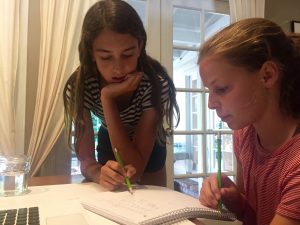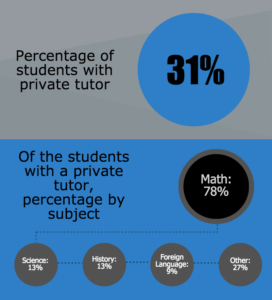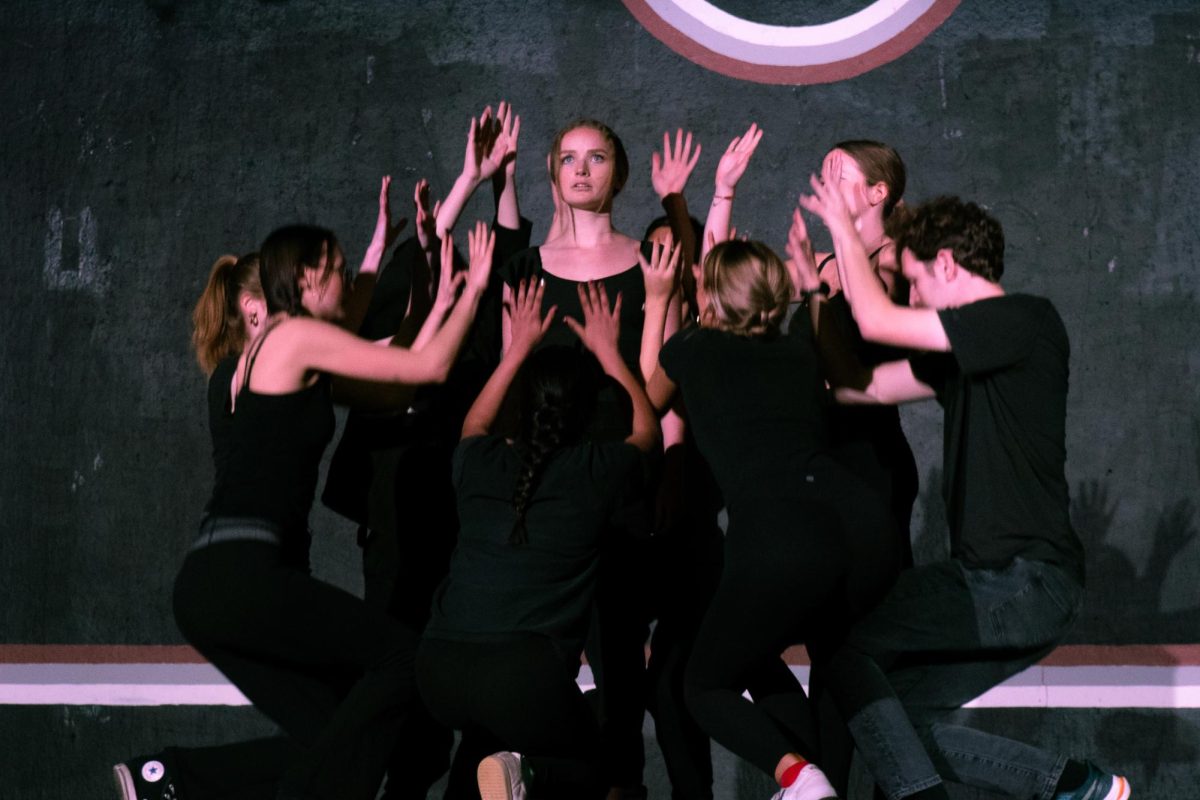Students sit at tables, their math homework in front of them. But instead of sitting in silent confusion like they usually do at school, these students are doing something they are often too afraid to do in class: ask questions. And their questions are immediately answered by the private tutor working side by side with them.
This image of students feeling comfortable enough to ask for the help they need is what inspired the creation of establishments like Kentfield Tutoring and countless other private tutoring programs in Marin—programs in high demand for Redwood students. According to the October Bark survey, of the 31 percent of students that have an academic tutor, 78 percent have one for math.
Sarah Ames, founder of Kentfield Tutoring, which mainly focuses on middle schoolers, was motivated to start her program after being both an elementary school math teacher and the mother of a son with a learning disability.
“I was just very of aware of, while how good our schools are, what some of the shortcomings were. And so I wanted to provide a resource for kids who need more than what’s offered at school,” Ames said.
Ames added that she thinks these shortcomings are on both ends of the learning spectrum, with students who need extra support in class and with students who are not being challenged enough. Ames finds both types of students at her program, which mainly focuses on math.
“I have a whole variety. Some kids come to me who need a little extra support—they struggle with math,

while probably a third of the people who come to me are looking for additional challenging math,” Ames said.
However, Ames said she thinks the main reason for the high demand in math tutors is not because of shortcomings in the school system.
“I think it’s more that most families don’t feel comfortable helping their kids with math,” Ames said. “Whereas they feel comfortable reading books with them or maybe reading an essay that they’ve written and giving them feedback or grammar or punctuation or content, I think a lot of the time they don’t feel comfortable doing that with math.”
Junior Lucas Marchi said he first got a tutor in math freshman year because it has always been a subject he has struggled with, and he knew it would only get harder in high school.
“Going into high school, the difficulty really ramped up, and in order to have a new understanding of the subject matter I needed some additional help outside of school,” Marchi said.
Although she does not think students should become reliant on a private tutor, math teacher and private tutor Allison Kristal does appreciate the personal level of teaching that it provides.
“I like the one-on-one relationship. I think that it’s more relaxed than when you are slammed during SMART period and you’re asked really fast questions, and I think that the students feel really comfortable around you,” Kristal said.
Marchi said that this one-on-one relationship has been beneficial for his learning.
“It’s created so that you can ask questions, and even if you don’t feel comfortable asking questions, you’re forced to have stuff explained to you. And it’s helpful to have reinforcement of topics and subjects,” Marchi said. “Sometimes they give you a different perspective.”
Marchi also said that having a private tutor has allowed him to not need as much time and help from his teacher.
“I don’t have to go to SMART period, or I don’t have to go to school early, because I can just go talk to my tutor instead,” Marchi said.
Allison Salzer, founder of ThinkMarin, another private tutoring program in Marin,, emphasizes teaching students to speak up for themselves and ask questions in class in her program, as she sees one of the drawbacks of private tutoring to be students becoming dependent on their tutor.
“One of the things the tutors always know to do is teach how to self-advocate and give [students]the tools to learn how to succeed on their own, instead of just relying on the tutor,” Salzer said.
According to Salzer, the purpose of her program is not solely to help students perform better in their classes, but to get them to the point where they don’t need a tutor and know how to study better on their own.

Kristal also thinks that private tutors should still allow students to think for themselves.
“I think that some students abuse having a tutor because they view it as someone who’s doing the thinking for them during the sessions, and that’s not, to me, a good tutor,” Kristal said.
Because of this, Kristal requires the students she tutors to come with their homework completed so that the session does not just become time to do homework, but instead a time to fine-tune their work.
However, according to Ames, teaching kids to be independent and self-sufficient is not an issue at her program.
“I think kids mostly want to be successful and want to be independent. I don’t think I’ve ever had it where it’s been a kid trying to get us to do his homework for him,” Ames said.
In contrast, according to Kristal, she often has to steer students in her classes away from solely relying on their tutor.
“If you have someone else who’s constantly doing the thinking for you, then how are you going to do that independently when the assessment comes?” Kristal said.
While Salzer says she understands these drawbacks to private tutoring, she ultimately thinks it is still beneficial for students.
“I do think if the kids are just relying on the tutor and not learning how to study on their own, or using the tutor as a crutch, that’s not good,” Salzer said. “But lot’s of times kids need extra support. There’s a lot of kids in the classroom, and you don’t have a lot of time to ask questions in the classroom, so if you need that extra support, a little deeper dive at home, I think it’s great.”
According to Kristal, she finds that students have tutors more often than actually necessary and many students do not take advantage of the accessibility of the math department.
Kristal believes that enough help is provided in the math department if students are proactive in seeking it out.
“We really do volunteer time. I think it’s become an expectation—go see your math teacher at lunch, when no one’s paying me to do that,” Kristal said. “I’m donating my time to see my students be successful.”
Kristal said she also believes that as a professional teacher, she is the best resource, both when teaching in class and when tutoring privately.
“Since I am a teacher, and I’ve taught like a thousand students in the subject, then I know these are the common mistakes that I see being made, and I can think up a new problem on the fly really easily,” Kristal said. “And I guess that’s the allure of having a teacher tutor, because we know the curriculum inside out.”
Salzer’s program also finds as well that the most helpful tutors also teach at schools, as they are trained to teach and study the subject matter every day, while peers do no not always know how to convey a topic as well.
Ames, however, said she sees a greater benefit in having high school students be tutors for kids in middle and elementary school.
“There’s something really nice about working with someone who’s five or six years ahead of where you are, because they work with adults like me all day long,” Ames said. “So when they have this cool kid who comes in who plays lacrosse, or won the science fair, or is close to your own age and is really motivated and excited and an expert in what you’re doing, it’s just, to me, really, really engaging.”
Kristal said she also understands the benefits of peer tutoring.
“Sometimes when I hear students talking to each other about concepts, I think they’re able to break it down into really simple language so it makes sense, so I think there’s an appeal to that,” Kristal said.
However, Kristal still does not believe that peers are always the best resource available as they are not able to elaborate or expand on an idea like a teacher can.
Kristal said for the kids who do need extra help outside of class, she prefers the options the school offers, particularly the math tutoring program created for students in Algebra I and Geometry, as opposed to a private tutor.
“I like that because I think that makes it more fair for students who have access. There are a lot of students here who have access to money, and we have plenty that don’t, so I think it levels the playing field by offering those services for kids,” Kristal said.
According to Ames, she gets very attached to both the kids she tutors and the tutors themselves, some of which she has worked with for more than four years.
“I mean, I love math, don’t get me wrong, but my favorite part is the different personalities that I get to see. They’re funny, and they’re quirky, and they tell me funny stories,” Ames said. “If I didn’t do this, I wouldn’t get to have all these interactions.”

















